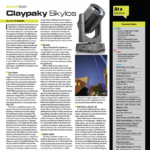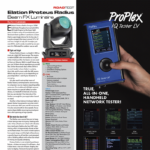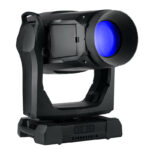A new safety device has been introduced to our business from Scotland recently, and has been making waves on this side of the Atlantic as well. The Uplift Fall Protection System establishes a new, intelligent way technicians as well as other people in the entertainment field will work on gear hanging in the air. Designed by Limpet Technology out of Edinburgh, this unique device leads us into a new age of safety when it comes to technicians, actors and anyone whose feet leave the ground in their work environment. Upstaging Lighting, a leading innovator in touring lighting systems, is proud to be the first American company to buy and utilize the Uplift Fall Prevention System (UFPS).
Goodbye, Gravity
This device secures itself to a truss or any house position such as a catwalk or gantry and aids in the lifting and lowering of personnel as they climb or work on gear. Not only does it prevent a user from accidentally falling, it aids in climbing as well as lifting and lowering people. Its many features differentiate it from any other product on the market today. Allow me to explain.
 The UFPS itself is a compact yellow and black box that holds 426 feet of safety line within a compact box measuring 30 by 20 by 16 inches. The unit can easily mount in multiple positions to some existing structure, such as a truss. The device itself weighs 139 pounds in its normal configuration but can hoist or support up to 319 pounds and/or two people simultaneously. It accepts 220-240 volts AC It accepts anywhere from 208-240 volts in (I am currently feeding 110 volts into a bucket transformer to get the 220 desired by the device). It has an internal brain with sensors that allows this instrument to be the ultimate climbing helper in five unique ways. The first of these is what one would think: it’s a fancy fall arrest system. I tried this on for myself by stepping into a harness and attaching it to a standard triple action carabiner on the end of the safety line. I jumped off the ground and clicked my feet up, expecting to fall a little before the fall arrest fixture clicked in. I did not drop an inch. The system held me afloat in the exact position my hips were in when I jumped. And then it weighed me.
The UFPS itself is a compact yellow and black box that holds 426 feet of safety line within a compact box measuring 30 by 20 by 16 inches. The unit can easily mount in multiple positions to some existing structure, such as a truss. The device itself weighs 139 pounds in its normal configuration but can hoist or support up to 319 pounds and/or two people simultaneously. It accepts 220-240 volts AC It accepts anywhere from 208-240 volts in (I am currently feeding 110 volts into a bucket transformer to get the 220 desired by the device). It has an internal brain with sensors that allows this instrument to be the ultimate climbing helper in five unique ways. The first of these is what one would think: it’s a fancy fall arrest system. I tried this on for myself by stepping into a harness and attaching it to a standard triple action carabiner on the end of the safety line. I jumped off the ground and clicked my feet up, expecting to fall a little before the fall arrest fixture clicked in. I did not drop an inch. The system held me afloat in the exact position my hips were in when I jumped. And then it weighed me.
That’s correct. The UFPS comes equipped with a brain and weight sensors. But the sensors are not just there to ensure that I do not weigh more than the allotted weight limit. It weighs me in order to help myself climb up any ladder, scaffolding or rope to a new height. While acting as a typical fall arrestor, it has an additional mode that is referred to as a climb assistant. In this mode, the device can take 80 or 90 percent of your weight while you climb; so your arms and legs seem to never tire. The user sets that percentage in advance. I trot over to the truss ladder to check it out. I fall backwards again to let the system weigh me, then place my foot in a standard truss ladder and start my ascent. Holy cow, it’s like an anti-gravity device. My feet and arms are swinging up, but there’s no weight in my thighs. It’s the feeling one gets when riding a bicycle downhill and pedaling with no effort. I could climb 60 feet in no time flat and never think of having to stop and catch my breath. There is constant tension on the line. Halfway up I let go of the ladder to scratch an itch on my head. The thing takes 100 percent of my weight immediately while I readjust my hard hat with both hands. As soon as I start climbing again, so does the device. It indeed has a brain of its own — and knows how to use it. When it’s time to descend, I do not need to change any modes. I stop briefly and take a slightly step up to release the climb assist and descend. This device simply allows me to climb down in the same matter, holding my weight up.
I’m told that actors in a recent Jesus Christ Superstar touring production use this device during the production when they have to climb set pieces. The actors cannot afford to be out of breath when they speak their lines after a quick vertical climb. And, of course, this device prevents the actors from falling once they climb as high as they’re going to go.
 Hello, Productivity
Hello, Productivity
Moving on to the third and coolest feature, in my book, is the UFPS’ ability to work as a personal personnel lift, all by itself. That’s right, folks. I can click in and press a button on the hand held controller and up I go. Not fast enough to scare myself — it ascends at a moderate 1.5 feet per second. The descend speed can be up to about twice that, and those speeds can be adjusted via the system’s LED control unit. I get to the top and can click onto a safety line before disengaging the wire to the safety unit. The guys on the ground can lower the line back down with a simple 10-pound sandbag attached. In the dimmers is an LED-lit control unit that can speak directly to the device. This RF unit has a three-button system. Up is a “dead man switch,” so when your finger comes off the button, the Limpet stops lifting. The down is a one-push hands-free descent, until you reach bottom, or press pause to stop and do whatever task you need to complete at any desired elevation. Once at the top, I switch modes and simply step off the truss and press the down button. The feeling is euphoric as I realize I am not going to die and the device starts lowering me. The ride is nice, but I personally would rather feel my feet on the ladder, and that makes me glad to have the climb assist option. But I imagine most truss spot operators would just as soon be lifted directly to their designated spot. At the stadium shows I work, the spot ops often have to climb 60 to 100 feet to get to their perch in the sky. This can take up to 10 minutes before they finish climbing and catch their breath. This will no longer be an issue on my shows.
Rapid Rescues, Too
The fourth feature of this device is the “Rapid Rescue” function. Unfortunately, technicians can hurt themselves while working in the air. I know a rigger who tore his rotator cuff while standing on a beam pulling up a chain. His shoulder was so torn up it took two riggers and an hour to help get him to the building’s catwalk. Had the production been carrying a UFPS, they could have quickly rigged it to an overhead steel beam, attached the injured worker, and lowered him in. He could have been at the hospital in minutes instead of hours. Twenty years ago, I had a truss spot suffer a heart attack in his seat over the audience. It came at the end of the performance. We needed to take 15 minutes to have a tech disconnect a lot of wires before we could lower the truss. The guy survived, but if we had one of these devices attached to his harness the entire show, we could’ve lifted him and gotten him down in minutes.
Lastly, people have been looking at this device as the future of Emergency Evacuation. Since it can run in self-mode, the premise is perfect for a fire evacuation. The people stranded on a floor above a fire have no way out other than a hook and ladder truck or to jump and hope they hit that circular trampoline thing below. Now they could clip a bosun’s chair (a seat typically used at sea to lift personnel off the deck) and have people sit in it one at a time and lower them in quickly using the self-running descend mode.
This device is smart — the line is always looking for tension and adjusts to weight immediately. It has a built in UPS that can last up to 40 minutes, ensuring it will work even during a power failure in the middle of operation. Nobody ever gets stuck in the air. There is also a manual wind/ratchet function to lower someone as a last, fail-safe resort. There also are two drum options available for bigger weight loads.
At a Glance
An Uplifting Idea
The Uplift Fall Protection System (UFPS) from Limpet Technology is compelling from a safety-first perspective. Not only does it promise to reduce hazards from accidental worker slips and falls, it could shorten the time now required to bring anyone aloft to medical attention in the event of an emergency. The system also holds great promise for other benefits including worker productivity and creative applications involving the cast, not just the crew.
UFPS from Limpet Technology
Pros: The pros for this device are limitless.
Cons: Zero. It’s a useful tool all around.
MSRP: Depending on the configuration, from $11,000 to $14,000.
More Info: limpettechnology.com



